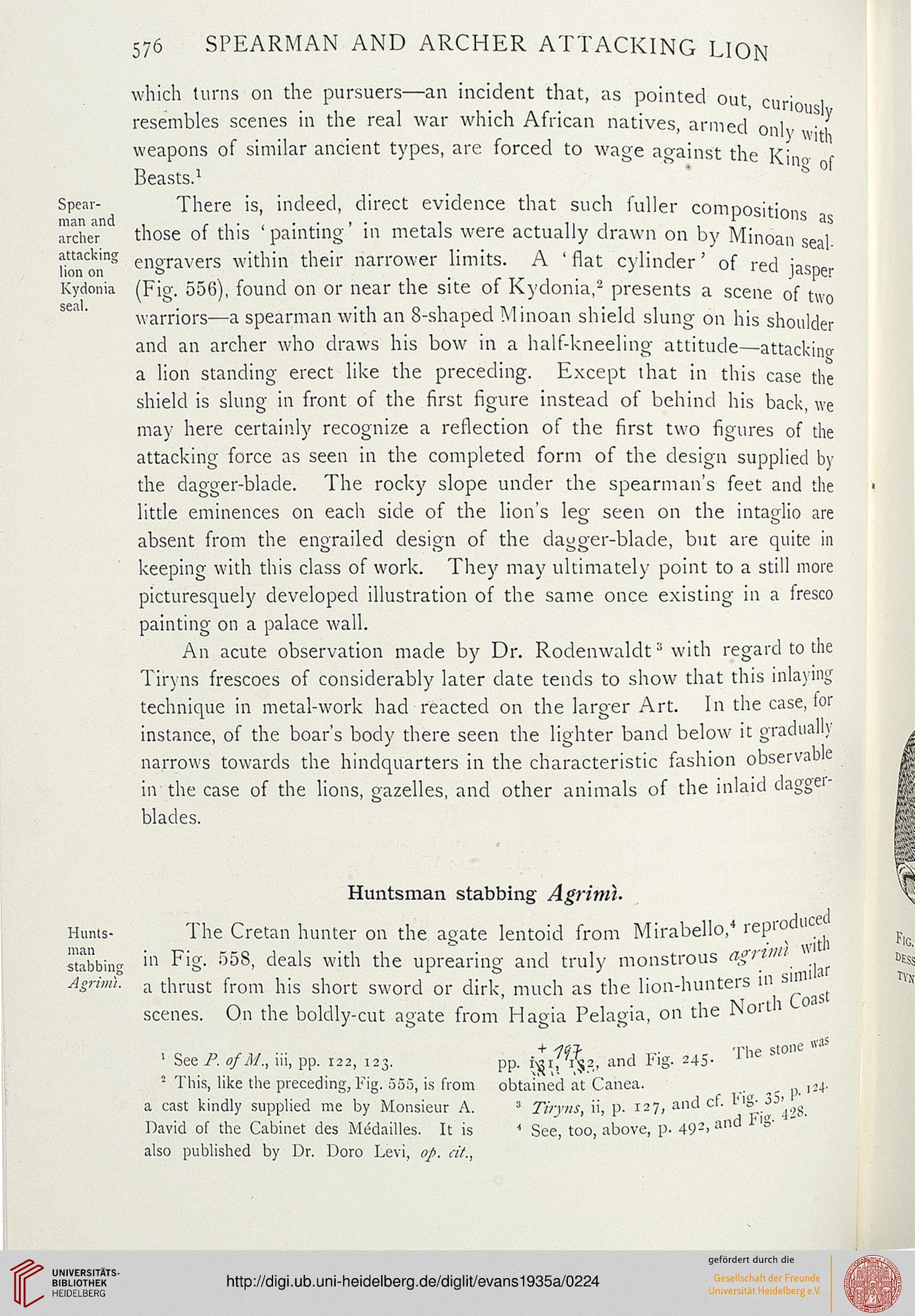seal
576 SPEARMAN AND ARCHER ATTACKING LION
which turns on the pursuers—an incident that, as pointed out
resembles scenes in the real war which African natives, armed onl ■ • 1
weapons of similar ancient types, are forced to wage against the Ki
Beasts.1
Spear- There is, indeed, direct evidence that such fuller comoosftinnc
man and , r ,...... , , 1,1 as
archer those of this painting in metals were actually drawn on by Minoan seal
attacking engravers within their narrower limits. A 'flat cylinder' of red Inc.
lion on & J l cu jasper
"ydonia (Fig. 556), found on or near the site of Kydonia,2 presents a scene of two
warriors—a spearman with an 8-shaped Minoan shield slung on his shoulder
and an archer who draws his bow in a half-kneeling attitude—attacking
a lion standing erect like the preceding. Except that in this case the
shield is slung in front of the first figure instead of behind his back, we
may here certainly recognize a reflection of the first two figures of the
attacking force as seen in the completed form of the design supplied by
the dagger-blade. The rocky slope under the spearman's feet and the
little eminences on each side of the lion's leg seen on the intaglio are
absent from the engrailed design of the dagger-blade, but are quite in
keeping" with this class of work. They may ultimately point to a still more
picturesquely developed illustration of the same once existing in a fresco
painting on a palace wall.
An acute observation made by Dr. Rodenwaldt3 with regard to the
Tiryns frescoes of considerably later date tends to show that this inlaying
technique in metal-work had reacted on the larger Art. In the case, for
instance, of the boar's body there seen the lighter band below it graduall)
narrows towards the hindquarters in the characteristic fashion observable
in the case of the lions, gazelles, and other animals of the inlaid dagger-
blades.
Huntsman stabbing Agrimi.
Hums- The Cretan hunter on the agate lentoid from Mirabello,4 reproc lie
"tabbing in F'g- 55S> deals with the uprearing and truly monstrous agnna *
Agrimi. a tllrust from his short sword or dirk, much as the lion-hunters in simi ^
scenes. On the boldly-cut agate from Hagia Pelagia, on the Nortn
' See P. o/M, iii, pp. r22, I23. pp. i^if^2, and Fig. =45- The Sl°nC
'- This, like the preceding, Fig. 555, is from obtained at Canea. _ . ,24.
a cast kindly supplied me by Monsieur A. 3 Tiryns, ii, p. 127, ancl c1' %-0 42S.
David of the Cabinet des M&lailles. It is * See, too, above, p. 492> and g'
also published by Dr. Doro Levi, op. at.,
576 SPEARMAN AND ARCHER ATTACKING LION
which turns on the pursuers—an incident that, as pointed out
resembles scenes in the real war which African natives, armed onl ■ • 1
weapons of similar ancient types, are forced to wage against the Ki
Beasts.1
Spear- There is, indeed, direct evidence that such fuller comoosftinnc
man and , r ,...... , , 1,1 as
archer those of this painting in metals were actually drawn on by Minoan seal
attacking engravers within their narrower limits. A 'flat cylinder' of red Inc.
lion on & J l cu jasper
"ydonia (Fig. 556), found on or near the site of Kydonia,2 presents a scene of two
warriors—a spearman with an 8-shaped Minoan shield slung on his shoulder
and an archer who draws his bow in a half-kneeling attitude—attacking
a lion standing erect like the preceding. Except that in this case the
shield is slung in front of the first figure instead of behind his back, we
may here certainly recognize a reflection of the first two figures of the
attacking force as seen in the completed form of the design supplied by
the dagger-blade. The rocky slope under the spearman's feet and the
little eminences on each side of the lion's leg seen on the intaglio are
absent from the engrailed design of the dagger-blade, but are quite in
keeping" with this class of work. They may ultimately point to a still more
picturesquely developed illustration of the same once existing in a fresco
painting on a palace wall.
An acute observation made by Dr. Rodenwaldt3 with regard to the
Tiryns frescoes of considerably later date tends to show that this inlaying
technique in metal-work had reacted on the larger Art. In the case, for
instance, of the boar's body there seen the lighter band below it graduall)
narrows towards the hindquarters in the characteristic fashion observable
in the case of the lions, gazelles, and other animals of the inlaid dagger-
blades.
Huntsman stabbing Agrimi.
Hums- The Cretan hunter on the agate lentoid from Mirabello,4 reproc lie
"tabbing in F'g- 55S> deals with the uprearing and truly monstrous agnna *
Agrimi. a tllrust from his short sword or dirk, much as the lion-hunters in simi ^
scenes. On the boldly-cut agate from Hagia Pelagia, on the Nortn
' See P. o/M, iii, pp. r22, I23. pp. i^if^2, and Fig. =45- The Sl°nC
'- This, like the preceding, Fig. 555, is from obtained at Canea. _ . ,24.
a cast kindly supplied me by Monsieur A. 3 Tiryns, ii, p. 127, ancl c1' %-0 42S.
David of the Cabinet des M&lailles. It is * See, too, above, p. 492> and g'
also published by Dr. Doro Levi, op. at.,





